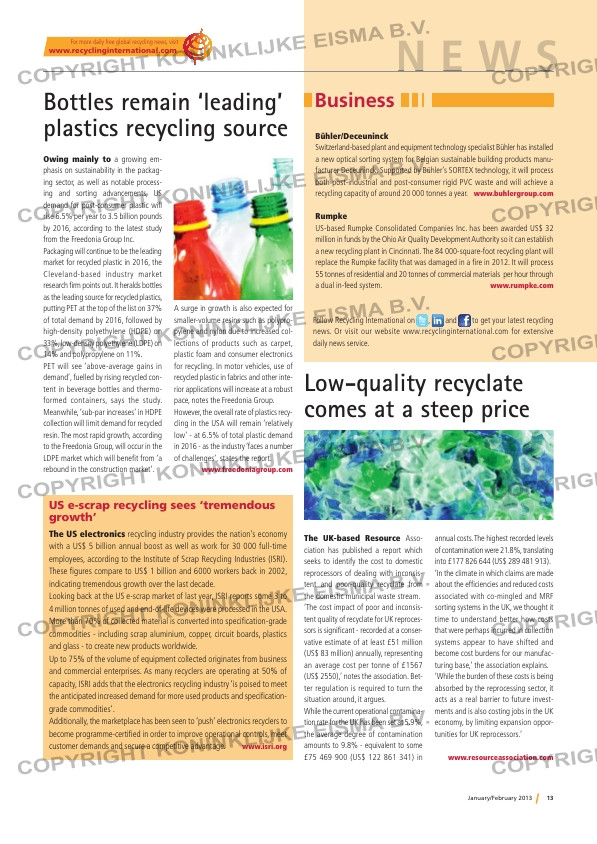Page 13 from: January / February 2013

Business
N E W S
13January/February 2013
For more daily free global recycling news, visit
www.recyclinginternational.com
The UK-based Resource Asso-
ciation has published a report which
seeks to identify the cost to domestic
reprocessors of dealing with inconsis-
tent and poor-quality recyclate from
the domestic municipal waste stream.
‘The cost impact of poor and inconsis-
tent quality of recyclate for UK reproces-
sors is signifi cant – recorded at a conser-
vative estimate of at least £51 million
(US$ 83 million) annually, representing
an average cost per tonne of £1567
(US$ 2550),’ notes the association. Bet-
ter regulation is required to turn the
situation around, it argues.
While the current operational contamina-
tion rate for the UK has been set at 5.9%,
the average degree of contamination
amounts to 9.8% – equivalent to some
£75 469 900 (US$ 122 861 341) in
annual costs. The highest recorded levels
of contamination were 21.8%, translating
into £177 826 644 (US$ 289 481 913).
‘In the climate in which claims are made
about the effi ciencies and reduced costs
associated with co-mingled and MRF
sorting systems in the UK, we thought it
time to understand better how costs
that were perhaps incurred in collection
systems appear to have shifted and
become cost burdens for our manufac-
turing base,’ the association explains.
‘While the burden of these costs is being
absorbed by the reprocessing sector, it
acts as a real barrier to future invest-
ments and is also costing jobs in the UK
economy, by limiting expansion oppor-
tunities for UK reprocessors.’
www.resourceassociation.com
Low-quality recyclate
comes at a steep price
Owing mainly to a growing em-
phasis on sustainability in the packag-
ing sector, as well as notable process-
ing and sorting advancements, US
demand for post-consumer plastic will
rise 6.5% per year to 3.5 billion pounds
by 2016, according to the latest study
from the Freedonia Group Inc.
Packaging will continue to be the leading
market for recycled plastic in 2016, the
Cleveland-based industry market
research fi rm points out. It heralds bottles
as the leading source for recycled plastics,
putting PET at the top of the list on 37%
of total demand by 2016, followed by
high-density polyethylene (HDPE) on
33%, low-density polyethylene (LDPE) on
14% and polypropylene on 11%.
PET will see ‘above-average gains in
demand’, fuelled by rising recycled con-
tent in beverage bottles and thermo-
formed containers, says the study.
Meanwhile, ‘sub-par increases’ in HDPE
collection will limit demand for recycled
resin. The most rapid growth, according
to the Freedonia Group, will occur in the
LDPE market which will benefi t from ‘a
rebound in the construction market’.
A surge in growth is also expected for
smaller-volume resins such as polypro-
pylene and nylon due to increased col-
lections of products such as carpet,
plastic foam and consumer electronics
for recycling. In motor vehicles, use of
recycled plastic in fabrics and other inte-
rior applications will increase at a robust
pace, notes the Freedonia Group.
However, the overall rate of plastics recy-
cling in the USA will remain ‘relatively
low’ – at 6.5% of total plastic demand
in 2016 – as the industry ‘faces a number
of challenges’, states the report.
www.freedoniagroup.com
Bottles remain ‘leading’
plastics recycling source
US e-scrap recycling sees ‘tremendous
growth’
The US electronics recycling industry provides the nation’s economy
with a US$ 5 billion annual boost as well as work for 30 000 full-time
employees, according to the Institute of Scrap Recycling Industries (ISRI).
These fi gures compare to US$ 1 billion and 6000 workers back in 2002,
indicating tremendous growth over the last decade.
Looking back at the US e-scrap market of last year, ISRI reports some 3 to
4 million tonnes of used and end-of-life devices were processed in the USA.
More than 70% of collected material is converted into specifi cation-grade
commodities – including scrap aluminium, copper, circuit boards, plastics
and glass – to create new products worldwide.
Up to 75% of the volume of equipment collected originates from business
and commercial enterprises. As many recyclers are operating at 50% of
capacity, ISRI adds that the electronics recycling industry ‘is poised to meet
the anticipated increased demand for more used products and specifi cation-
grade commodities’.
Additionally, the marketplace has been seen to ‘push’ electronics recyclers to
become programme-certifi ed in order to improve operational controls, meet
customer demands and secure a competitive advantage. www.isri.org
Bühler/Deceuninck
Switzerland-based plant and equipment technology specialist Bühler has installed
a new optical sorting system for Belgian sustainable building products manu-
facturer Deceuninck. Supported by Bühler’s SORTEX technology, it will process
both post-industrial and post-consumer rigid PVC waste and will achieve a
recycling capacity of around 20 000 tonnes a year. www.buhlergroup.com
Rumpke
US-based Rumpke Consolidated Companies Inc. has been awarded US$ 32
million in funds by the Ohio Air Quality Development Authority so it can establish
a new recycling plant in Cincinnati. The 84 000-square-foot recycling plant will
replace the Rumpke facility that was damaged in a fi re in 2012. It will process
55 tonnes of residential and 20 tonnes of commercial materials per hour through
a dual in-feed system. www.rumpke.com
Follow Recycling International on , and to get your latest recycling
news. Or visit our website www.recyclinginternational.com for extensive
daily news service.
RI_1-NEWS.indd 13 28-01-13 16:16



